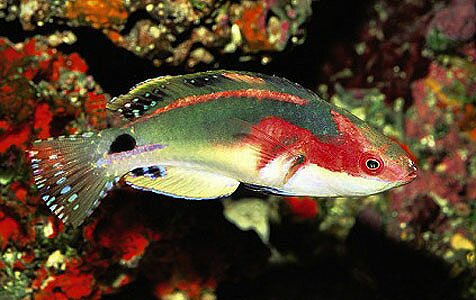Exquisite Fairy Wrasse
From Microcosm Aquarium Explorer

A coveted reef fish for a community of more peaceful fishes. Scott W. Michael
Overview
Green and glorious, this colorful wrasse is a welcome addition to the more passive fish-only tank or reef aquarium. It can be housed in small harems with a single male and several females.
Family: Labridae
Other common name(s):
- Exquisite Wrasse
Native range:
Habitat: Reef. This fish needs plenty of swimming room as well as rocky crevices and niches where it can duck into shelter when it feels threatened.
Maximum length: 12 cm (5 in)
Minimum aquarium size: 209 L (55 gal)
Water: Marine 24 °C (75 °F) - 28 °C (82 °F)
General swimming level: All levels.
Feeding
Carnivore. Feed meaty foods such as mysid shrimp and enriched brine shrimp several times a day.
Aquarium Compatibility
This fairy wrasse can be housed with a wide variety of tankmates. In larger tanks, it rarely bothers other fishes, with the possible exception of related species (males may pester other fairy wrasses or flasher wrasses). It is more often the victim of harassment by dottybacks, large damsels, hawkfishes, angels, sandperches and triggers. Keep one male per tank. Females can be housed together and with males. Males are more colorful, sporting large areas of red on the head (if from Indian Ocean) or bright red on the fins (if from Pacific). It does not pose a threat to ornamental invertebrates.
Breeding/Propagation
Egg scatterers that produce pelagic eggs, often in midwater mating rituals. Both eggs and larvae that drift with plankton in the water column and settle back onto a reef at about the time of metamorphosis. These are among the most challenging types of marine fishes to propagate in captivity.
Notes
As with others in the genus, it often bobs along as it swims in the water column waiting for zooplankton-like food items to appear. It will perform fabulous displays toward members of its own kind during which the color will intensify. An aquarium top is mandatory to keep this species from leaping out.








